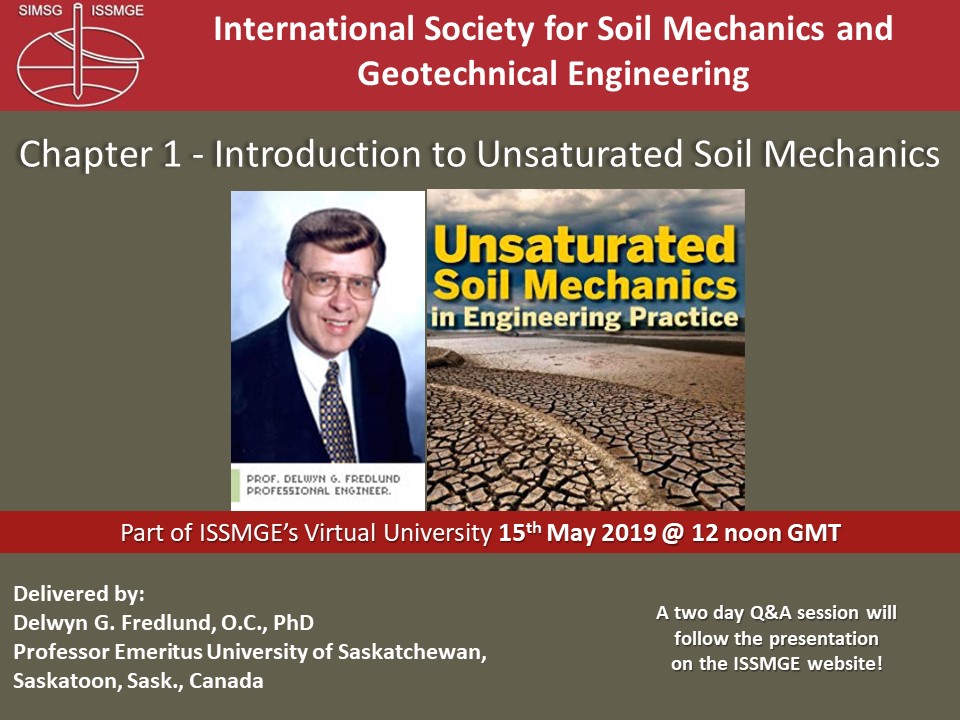About This Course
This course is based on notes presented in the book “Unsaturated Soil Mechanics in Engineering practice” published in 2012 by prof. Delwyn G. Fredlund. The objective of the course is to introduce unsaturated soil mechanics within the framework of classical soil mechanics by incorporating soil suction. It includes 6 Chapters, with titles and summaries as follows:
Chapter 1 - Introduction to Unsaturated Soil Mechanics (41 min). The first lecture introduces unsaturated soils by illustrated practical problems. The link between field and laboratory conditions is established by the “Soil-Water Characterization Curve” (SWCC) also called the soil retention curve.
Chapter 2 - State Variables and their Measurement (34 min). The second lecture presents the state variables by which the transition from the saturated soil condition to the unsaturated soil condition can be described, in particular the matric suction as the difference between pore-air and pore-water pressures. The measurement of soil suction helps in linking the state of stresses in field and laboratory conditions.
Chapter 3 - The Soil-Water Characteristic Curve, SWCC (50 min). The third lecture details the determination of SWCC in providing information about the amount of water and the energy state in water phase. The experimental measurement of the SWCC is explained and inherent parameters depending on the type of soil are introduced.
Chapter 4 - Seepage through Unsaturated Soils (51 min). The fourth lecture is dedicated to the theory and solution dealing with water flow problems in unsaturated soil. Focus is made on the measurement of unsaturated coefficient of permeability function for design purposes. Steady state and unsteady (transient) state methodologies are explained for the calculation of unsaturated coefficients of permeability. Selected water flow case studies are shown.
Chapter 5 - Shear Strength of Unsaturated Soils (45 min). Lecture five addresses the determination of shear strength of unsaturated soils. The latter is described by two independent state variables among which soil suction contributes to the cohesive component of soil. Measurement of shear strength of unsaturated soils is conducted by the conventional shear box and triaxial equipment needing modifications to allow air-entry in tested specimens. Using the shear strength parameters of unsaturated soil, current soil mechanics applications: e.g. earth pressures, bearing capacity and slope stability of foundations are formulated.
Chapter 6 - Volume Change & Deformation of Unsaturated Soils (39 min). In the sixth lecture, the theory with related solution of stress deformation problems is investigated. The main objective is to establish the relation between stress state variables and deformation strain state variables for unsaturated soils. In this process, the use of SWCC enables the assessment of the behaviour of unsaturated soil.



![Intelligent Compaction {"category":"webinar","subjects":["Ground Improvement", "Soil Mechanics"],"number":"GI102","instructors":["Antonio Correia","George Chang"]}](/asset-v1:ISSMGE+GI102+2011+type@asset+block@pic5.jpg)
![Role of the Soil-Water Characteristic Curve in Unsaturated Soil Mechanics (Geoffrey Blight Lecture - 19th ICSMGE) {"category":"honour_lecture","subjects":["Soil Mechanics"],"number":"ICSMGE19106","instructors":["Delwyn G. Fredlund"]}](/asset-v1:ISSMGE+ICSMGE19106+2017+type@asset+block@geoffrey-blight-lecture.jpg)
![On the Fabric and State Parameters of Active Clays for Contaminant Control (R. K. Rowe Lecture - 19th ICSMGE) {"category":"honour_lecture","subjects":["Contaminant Transport", "Soil Mechanics"],"number":"ICSMGE19114","instructors":["Mario Manassero"]}](/asset-v1:ISSMGE+ICSMGE19114+2017+type@asset+block@rowe-lecture.jpg)
![Soil Behaviour {"category":"course","subjects":["Soil Mechanics"],"number":"SB-101","instructors":["Fumio Tatsuoka", "Eduardo Alonso", "Pierre Delage"]}](/asset-v1:ISSMGE+SB-101+2021+type@asset+block@cover.jpg)
![Introduction to Slope Engineering {"category":"course","subjects":["Numerical and Constitutive Modelling","Soil Mechanics","Slope Stability"],"number":"GEE2020-1","instructors":["Wu Shunchuan"]}](/asset-v1:ISSMGE+SE101+2023+type@asset+block@intro-slide.jpg)
![What Happens When Soil Compresses {"category":"short_edu","subjects":["Settlements"],"number":"SEV101","instructors":["Marina Pantazidou"]}](/asset-v1:ISSMGE+SEV101+2020+type@asset+block@what-happens-when-soil-compresses.jpg)
![Unsaturated Soils: Basic Concepts and Applications (Part 1 and Part 2) {"category":"webinar","subjects":["Soil Mechanics"],"number":"SM101","instructors":["Eduardo Alonso"]}](/asset-v1:ISSMGE+SM101+2012+type@asset+block@pic3.jpg)
![Soil Characterisation {"category":"course","subjects":["Soil Mechanics","In-situ Testing","Residual Soils","Settlements","Laboratory Testing"],"number":"VU-SC","instructors":["Cor Zwanenburg","Samuel Kofi Ampadu","Gabriel Auvinet","Serge Leroueil","Richard Jardine"]}](/asset-v1:ISSMGE+TC102-002+2017+type@asset+block@Leroueil-small.jpg)
![Undergraduate teaching of Unsaturated Soil Mechanics: Building on fundamental physical mechanisms to pave the way for geotechnical analyses {"category":"talk","subjects":["Teaching Geotechnics", "Soil Mechanics"],"number":"TC306-GEE2025-05","instructors":["Alessandro Tarantino", "Alessia Amabile"]}](/asset-v1:ISSMGE+TC306-GEE2025-05+2025+type@asset+block@tarantino-amabile.png)